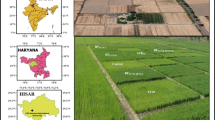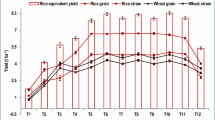Abstract
High fertilizer use efficiency in rice (Oryza sativa L.)-based cropping systems in Indo-Gangetic Plains (IGP) is not achieved because farmers’ fertilizer practices (FFP) and blanket state recommendations (BSR) do not take into account the site-specific variability of nutrient availability in the soil. We evaluated the site-specific nutrient management (SSNM) option against existing FFP, blanket state recommendation (BSR), improved BSR (IBSR i.e., 25 % higher than BSR), and state soil testing laboratory recommendation (STLR) in six pre-dominant rice-based cropping systems namely wheat–rice (W–R), mustard–rice (M–R), potato–rice (P–R), garlic–rice (G–R), chickpea–rice (C–R) and berseem fodder–rice (B–R) in terms of yield gain, economics, nutrient harvest index, soil fertility, and apparent nutrient balances. System rice equivalent yield (SREY) improved by 15.7, 9.5, 13.9 and 30 %, in SSNM over BSR, IBSR, STLR and FFP, respectively. SSNM involved additional cost of ₹ 2940–5291 ha−1 over BSR and ₹ 5492–10120 ha−1 over FFP under different cropping systems but contributed higher added net return of ₹ 23236–75056 ha−1 and ₹ 39577–143899 ha−1 over BSR and FFP, respectively. The output: input ratio and nutrient harvest index for N, P, K were also highest in SSNM. At the end of the experiment, soil available N, Olsen-P and available K content were either maintained or improved over their initial values in SSNM treatments, whereas soil available K in FFP declined by −1.65 % and increased over initial content in BSR and STLR in 0–15 cm soil profile depth. After three crop cycles, apparent N and P balances were positive in all the cropping systems and fertilizer treatments; only exception was a negative N balance in C–R and B–R systems in different fertilizer treatments. The apparent K balances were negative in all the cropping systems irrespective of nutrient management options. But, the magnitude of negative balance was lower in plots received SSNM treatment as compared to other nutrient management strategies, indicating a potential for improving yields, nutrient use efficiency and farm profit without deteriorating soil fertility in different rice based systems in IGP.


Similar content being viewed by others
Abbreviations
- IGP:
-
Indo-Gangetic Plain
- FFP:
-
Farmers’ fertilizer practices
- BSR:
-
Blanket state recommendations
- SSNM:
-
Site-specific nutrient management
- STLR:
-
Soil testing laboratory recommendation
- SREY:
-
System rice equivalent yield
- UGP:
-
Upper Gangetic Plain
- RIE:
-
Reciprocal Internal Efficiency
- AICRP:
-
All India Coordinated Research Project
- INS:
-
Indigenous nutrient supply
- IBSR:
-
Improved blanket state recommendation
- MSP:
-
Minimum support price
- NHI:
-
Nutrient harvest index
References
Aulakh MS, Malhi SS (2004) Fertilizer nitrogen use efficiency as influenced by interactions of N with other nutrients. In: Mosier A, Syers JK, Freney JR (eds) Agriculture and the nitrogen cycle: assessing the impact of fertilizer use on food production and the environment. Island Press, Covelo, pp 181–191
Awonaike KO, Kumarasinghe KS, Danso SKA (1990) Nitrogen fixation and yield of cowpea (Vigna unguiculata) as influenced by cultivar and Bradyrhizobium strain. Field Crops Res 24:163–171
Buresh RJ, Pampolino MF, Witt C (2010) Field-specific potassium and phosphorus balances and fertilizer requirement for irrigated rice-based cropping systems. Plant Soil 335:35–64
Dobermann A, Cassman KG, Sta. Cruz PC, Adviento MA, Pampolino MF (1996) Fertilizer inputs, nutrient balance, and soil nutrient-supplying power in intensive, irrigated rice ecosystems. II. Effective soil K supplying capacity. Nutr Cycling Agroecosyst 46:11–21
Dwivedi BS, Singh Dhyan-, Chhonkar PK, Sahoo RN, Sharma SK, Tiwari KN (2006) Soil fertility evaluation-A potential tool for balanced use of fertilizers. IARI, New Delhi and PPI/PPIC-India Programme, Gurgaon, pp 1–60
Dwivedi BS, Shukla Arvind K, Singh VK, Yadav RL (2003) Improving nitrogen and phosphorus use efficiencies through inclusion of forage cowpea in the rice-wheat system in the Indo-Gangetic Plains of India. Field Crops Res 84:399–418
FAI (2011) Fertiliser statistics (2010–11). Fertiliser Association of India, New Delhi
Helmke PA, Sparks DL (1996) Lithium, sodium, potassium, rubidium, and cesium. In: Sparks DL et al (ed) Methods of Soil Analysis, Part 3. Chemical methods. SSSA Book Series No. 5, SSSA, Madison, WI, pp 551-574
Khan MA, Shukla Arvind K, Upadhayay NC, Singh OP, Singh BP (2007) System productivity and soil status with different nutrient management options in sorghum (fodder)-potato-chickpea cropping system. Potato J 34(1–2):115–116
Ladha JK, Yadvinder-Singh Erenstein O, Hardy B (2009) Integrated crop and resource management in the rice–wheat system of South Asia. International Rice Research Institute, Los Banos
Olsen SR, Cole CV, Watanabe FS, Dean LA (1954) Estimation of available phosphorus in soils by extraction with sodium bicarbonate. USDA Circ. 939, USDA, Washington DC
Piper CS (1966) Soil and plant analysis. University of Adelaide Press, Adelaide
Prasad R (2006) Zinc in soils and in plant, human and animal nutrition. Indian J Fertil 2(9):103–119
Shukla Arvind K, Khan MA, Upadhayay NC, Singh OP (2005) Evaluation of nutrient management options for rice-potato-wheat cropping system of upper gangetic plain region. Potato J. 32(3–4):159–160
Shukla Arvind K, Ladha Jagdish K, Singh VK, Dwivedi BS, Balasubramanian V, Gupta Raj K, Sharma SK, Singh-Yogendra PH, Pandey PS, Padre Agnes T, Yadav RL (2004) Calibrating the Leaf Color Chart for nitrogen management in different genotypes of rice and wheat in a systems perspective. Agron J 96:1606–1621
Singh M, Dwivedi BS, Dutta SP (2012) Integrated nutrient management for enhancing productivity, nutrient use efficiency and environmental quality. In: Goswami NN et al (eds) Soil science in the service of nation. ISSS, New Delhi, pp 55–67
Singh VK, Dwivedi BS (2006) Yield and nitrogen use-efficiency in wheat, and soil fertility status as influenced by substitution of rice with pigeon pea in a rice-wheat cropping system. Aust J Exp Agric 46:1185–1194
Singh VK, Dwivedi BS, Buresh RJ, Jat ML, Majumdar K, Gangwar B, Govil V, Singh SK (2013) Potassium fertilization in rice-wheat system on farmer’s fields in India: crop performance and soil nutrients. Agron J 105:471–481
Singh VK, Dwivedi BS, Shukla AK (2006) Yield, nitrogen and phosphorus use efficiency as influenced by fertiliser NP additions in wheat under rice-wheat and pigeonpea-wheat system on a Typic Ustochrept soil. Indian J Agric Sci 76(2):114–119
Singh VK, Dwivedi BS, Shukla AK, Chauhan YS, Yadav RL (2005) Diversification of rice with pigeonpea in a rice-wheat cropping system on a Typic Ustochrept: effect on soil fertility, yield and nutrient use efficiency. Field Crops Res 92:85–105
Singh VK, Dwivedi BS, Shukla AK, Mishra RP (2010) Permanent raised bed planting of the pigeonpea–wheat system on a Typic Ustochrept: effects on soil fertility, yield and water and nutrient use efficiencies. Field Crops Res 116:127–139
Singh VK, Dwivedi BS, Tiwari KN, Majumdar K, Rani Meenu, Singh Susheel K, Timsina J (2014) Optimizing nutrient management strategies for rice–wheat system in the Indo-Gangetic Plains of India and adjacent region for higher productivity, nutrient use efficiency and profits. Field Crops Res 164:30–44
Singh VK, Sharma BB, Dwivedi BS (2002) The impact of diversification of a rice-wheat cropping system on crop productivity and soil fertility. J Agric Sci 139:405–412
Singh VK, Govil V, Singh SK, Dwivedi BS, Meena MC, Gupta VK, Majumdar K, Gangwar B (2012) Precision nutrient management strategies using GIS-based mapping in Western Uttar Pradesh. Better Crops-South Asia 6(1):15–18
Subbiah BV, Asija GL (1956) A rapid procedure for the determination of available nitrogen in soils. Current Sci 25:259–260
Swarup A, Wanjari RH (2000) Three Decades of All India Coordinated Research. Project on Long-term Fertilizer Experiments to Study Changes in Soil Quality, Crop Productivity and Sustainability. IISS, Bhopal, India
Timsina J, Connor DJ (2001) Productivity and management of rice-wheat cropping systems: issues and challenges. Field Crops Res 69:93–132
Witt C, Dobermann A, Abdulrachman S, Gines HC, Wang G, Nagarajan R, Satawatananont S, Son TT, Tan PS, Tiem LV, Simbahan GC, Olk DC (1999) Internal nutrient efficiencies of irrigated lowland rice in tropical and sub-tropical Asia. Field Crops Res 63:113–138
Yadvinder-Singh, Bijay-Singh (2001) Efficient management of primary nutrients in the rice–wheat system. J Crop Prod 4:23–85
Zhu ZL, Chen DL (2002) Nitrogen fertilizer use in China contributions to food production, impacts on the environment and best management strategies. Nutr Cycling Agroecosyst 63:117–127
Acknowledgments
We are thankful to the International Plant Nutrition Institute (IPNI) for providing financial support for this study. We acknowledge the encouragement and facilities provided for the field and lab studies by Director, Indian Institute of Farming Systems Research, Modipuarm, India.
Author information
Authors and Affiliations
Corresponding author
Rights and permissions
About this article
Cite this article
Singh, V.K., Shukla, A.K., Dwivedi, B.S. et al. Site-Specific Nutrient Management under Rice-Based Cropping Systems in Indo-Gangetic Plains: Yield, Profit and Apparent Nutrient Balance. Agric Res 4, 365–377 (2015). https://doi.org/10.1007/s40003-015-0179-1
Received:
Accepted:
Published:
Issue Date:
DOI: https://doi.org/10.1007/s40003-015-0179-1




